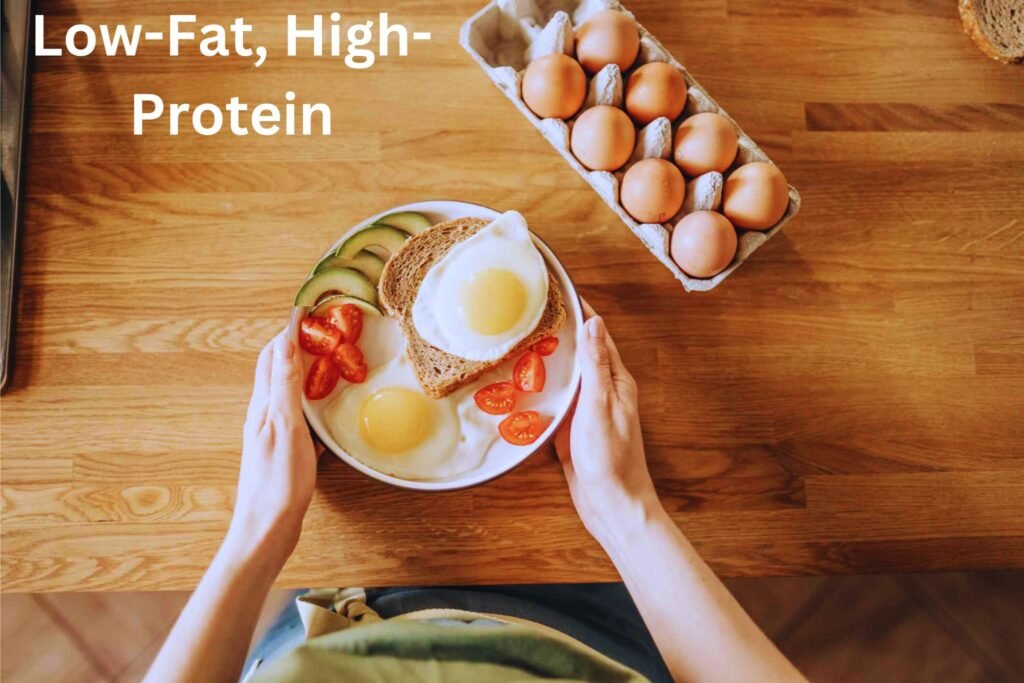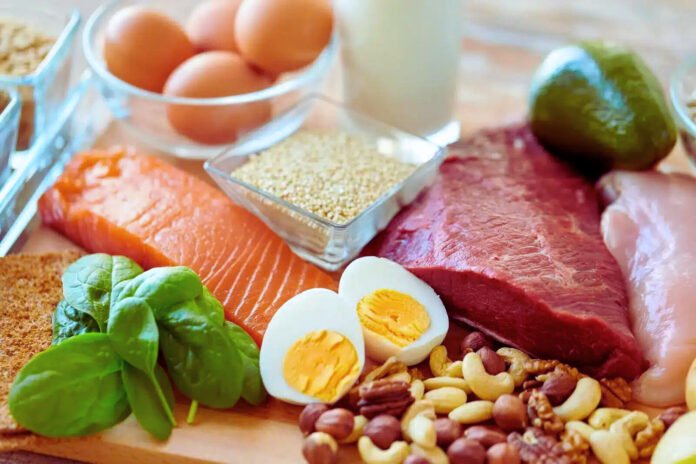Introduction:
Low-Fat, High-Protein, we need to eat a diet rich in protein to be well. A well-balanced diet should include protein as it plays a vital role in the development of the body and the healing of damaged tissues. It also ensures that the body’s systems operate as intended. However, what happens if the foods high in protein also include more fat and calories than we need? This suggests that we have to decide.

1. Low-Fat, High-Protein Yogurt (plain) (Greek Yogurt)
Unlike ordinary yogurt, plain or Greek yoghurt is made by skipping the liquid whey during the manufacturing process. As a result, the yoghurt has a creamier texture, is significantly lower in fat, and contains more protein. This is an excellent option if you’re searching for a low-fat, high-protein lunch. It’s reasonable to estimate that 170 grams of Greek yogurt contain around 20 grams of protein.
You may pair a Greek yogurt drink with a low-calorie snack like cheese or eggs. The good news is that you can eat it as a late-night snack because of the tryptophan it contains. Tryptophan improves the quality of sleep.
Greek yogurt, also known as plain yogurt, is a fermented dairy product that is thickened by filtering out whey and other liquids from the yogurt. It has a lot of calcium, probiotics, protein, and other important elements. Due to its adaptability, it is a preferred option for breakfast, snacking, and cookery in many different cultures around the globe.
2. Poultry with white meat
Not only is white meat tasty, but it also contains a surprisingly high amount of essential proteins. An impressive 30 grams of protein are included in 100 grams of boiled or roasted turkey—that’s a lot of protein!
The breasts and wings contain the majority of the protein in white meat. This indicates that the fat content of chicken or turkey breasts is lower than that of the legs, thighs, and other parts of the bird. Skin from fowl has a greater fat content than breast meat! You may have skinless chicken flesh as a low-fat, high-protein lunch.
3. Whites of eggs
These eggs contain more than half the protein found in regular eggs in the egg white. Although the yolk has many other Low-Fat, High-Protein healthy components, including cholesterol, it also has a large amount of fat and calories.
We suggest limiting your dinner options to simply egg whites if you’re searching for a low-fat, high-protein meal. When compared to egg yolks, egg whites include less fat and more protein. Their high protein content can aid in improved sleep, making them, like yogurt, a great late-night snack.
4. Dairy
5. Tuna fish
Eating tuna at any time of day is a terrific way to get your protein fix. The fish are of the saltwater kind. Its meat has few calories, little fat, and a high protein content. Together with vitamins and other healthy elements, it also has Omega-3 fatty acids, which have antioxidant properties.
It pairs nicely with a range of vegetables and, for some, even cheese. It may be eaten hot or cold and Low-Fat, High-Protein. It is delicious and nutritious enough to consume in the late hours of the night. However, because the oil contains a lot of calories, eating fried tuna fish is not advised.
6. Shrimp
One of the best kind of seafood is shrimp. They are rather bigger than crawfish, though. Due to their high protein content and abundance in other nutrients like riboflavin and selenium, shrimp are a wonderful option for a low-fat, high-protein diet.
Shrimp contains so few calories and Low-Fat, High-Protein that a 3-ounce portion offers only 84 calories and about 20 grams of protein. Some persons get allergic reactions after eating seafood. This has to do with underlying allergies, where the body fights against specific molecules it mistakenly perceives as antigens in shellfish. You should refrain from eating seafood if it causes you to react negatively.
7. Bison
Buffalo, often referred to as bison, is believed to contain Low-Fat, High-Protein and healthier than beef. It is estimated that the fat content of beef is almost double that of bison per ounce. When it comes to nutrition, bison is far superior to beef.
There’s also ALA and omega-3 fatty acids. Red meat is typically not advised, while bison is not red meat. But it’s a leaner meat that may still be considered a high-protein, low-fat meal when compared to beef.
8. Cottage cheese with low fat
Protein content in cottage cheese is high. It’s reduced in fat and calories, making it even better. Kids really enjoy it, and it tastes well too. Cheese has a lot of calcium, which is good for growing strong teeth and bones.
The majority of producers also add vitamin D, which supports the parathyroid glands and helps with calcium absorption and use. It is possible to flavor cottage cheese to suit the preferences of the customer. It’s a great late-night snack that goes nicely with other fat-free beverages and Low-Fat, High-Protein. Cheese and Greek yogurt are a great combination to take just before bed.
9. Fish with a white fleece
Fish with white flesh have a high protein level and a low fat content. About 25 grams of protein and 120 calories should be found in 100 grams of simply cooked white meat fish. Fish with white flesh include anti-inflammatory fatty acids such Omega-3 fatty acids and ALA.
Among them are haddock, tilapia, pollock, flounder, and other fish species. White-fleshed fish are usually easily found if you live close to a river since they are often sold at beach markets. If you don’t have one, white-fleshed fish may be purchased at marts and supermarkets. They would be sold as frozen meals and also Low-Fat, High-Protein.
10. Legumes
Plants in the Fabaceae family include legumes. One form of legume that is low in fat and calories but high in protein and fiber is called a pulse. Pulses include beans, lentils, and peas. In comparison to other foods, pulses are regarded to have a low calorie content and an average of 8 grams of protein per 100 grams.
Pulses and a variety of other meals include fiber, which has been demonstrated to lower blood pressure and Low-Fat, High-Protein and facilitate easier bowel movements. Moreover, fibers aid in bowel movements and digestion. Additionally, legumes make a wholesome late-night snack.
The plant family known as legumes include chickpeas, lentils, peas, and beans. Because of their high protein content, they are highly valued and considered a global food staple, particularly for vegetarian and vegan diets. Legumes are nutrient-dense and advantageous for blood sugar regulation, weight control, and heart health since they also include fiber, vitamins, and minerals. Furthermore, they aid in sustainable agriculture by adding nitrogen to the soil via a process known as nitrogen fixation.


